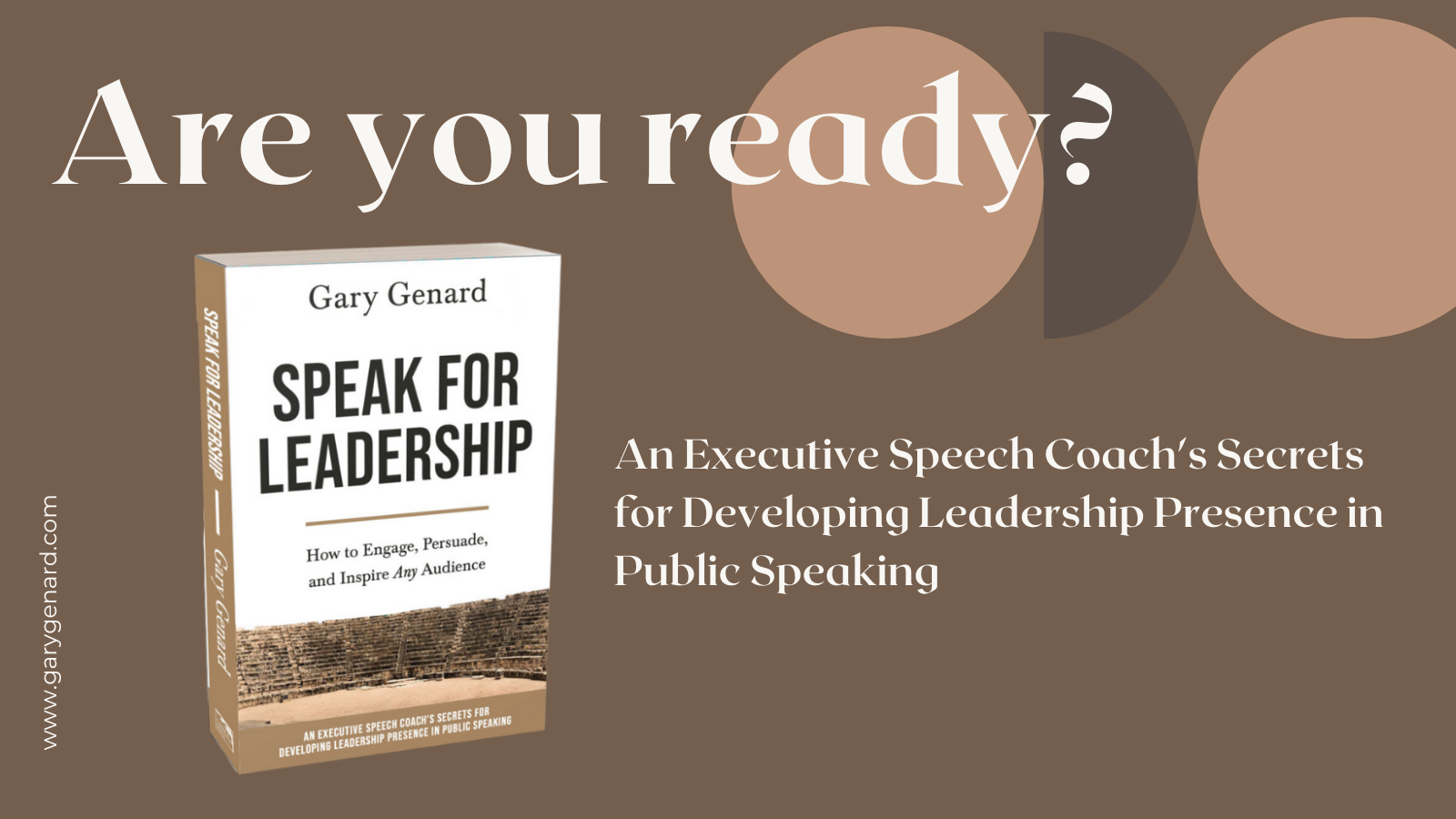Talking with someone face to face is the richest and most immediate way to gain influence. So, to change the world, make your writing sound like speaking.
Would you like to change the world for the better, in a small or big way? Do you speak publicly in person or virtually as part of your job?
If your answer is yes to both questions, I have a prescription for success, one that's simple and powerful. It's making your writing sound more like speaking.
Are you ready to gain maximum influence with stakeholders? Find out how in my book, Speak for Leadership: An Executive Speech Coach's Secrets. Find it here on Amazon.
Hey, Don't Give That Speech — Talk to Us!
If you have a time machine handy, take a hop back to, oh, 1896, and attend the Democratic National Convention in Chicago to hear William Jennings Bryan's "Cross of Gold" speech. It is one of the most famous orations in American history—and it's that word 'oration' that we're concerned about here.
As you sit in the convention hall on that July day, you'll hear phrases like, "I come to speak to you in defense of a cause . . . " and: "The individual is but at atom: he's born, he acts, and he dies." But everyone sitting around you will be paying rapt attention, for this was the age of oratory in America, and Bryan was acknowledged as the past master of the form.
To speak as one of today's leaders, download my Free ebook, High-Impact Speaking: The Leader's Guide to Presenting With Integrity and Influence. Tap into your natural talents!
We don't speak like that anymore, even in highly formal occasions like a speech at a political convention or an inaugural address. Nowadays, we just talk . . . or we should do so. That's because we recognize (even if we don't formulate the actual thought) that a conversation is the best medium for allowing us to express ourselves and be heard in turn.
The Beauty of Conversational Speaking
You and your audience are at your best in a conversation. When you are focused as a speaker on "just talking" (rather than looking good, making an impression, etc.), you look, sound, move, and think like yourself. You're natural and not calculating the odds of success every second. Best of all, you're giving listeners exactly what they are interested in hearing: what you, not the success devil on your shoulder, are showing them and sharing with them.
Learn how to gain maximum stage presence. Get my Free resource, How to Speak As a Leader: The Power of Performance. Raise the bar when your credibility is on the line!
Your audience, too, is relaxed and able to relate to you with ease. The more formal and distant you are (literally and metaphorically), the more removed from you they will feel. That has implications, not only for your ability to reach them emotionally and connect with them, but whether they are willing to take part in the conversation. For instance, if an audience member has an important question, they may not feel comfortable asking it if you're the figure standing behind the lectern and reading verbatim from notes or slides. And if that person has questions, you can bet others do too. If no one speaks up, you're seriously reducing your chance to give listeners what they need.
Put Down That Pen and Start Talking!
In my book, Speak for Leadership, and in my speech coaching practice, I advocate a plan of action that will help you make your writing sound like speaking. It's in the chapter entitled, "Why You're a Natural Performer," and it's all about making your ideas come to life when you speak in public—from pitches to business presentations to virtual meetings to conference speeches. Another way to categorize my method is that it helps you prepare a speech (or remarks) with your audience in mind.
And learn how to start out strong! Get my Free Guide, How to Begin a Presentation: The Critical First 60 Seconds. Discover how to connect with audiences when it matters most!
Here's how my system works: Most speakers prepare a talk this way: Think → Write → Speak. That is, they have some ideas (THINK), which they then write down as notes or in a slide deck (WRITE). After polishing this document, it's time to show up and deliver their speech (SPEAK). But there's a huge problem with this approach: you may find yourself on stage or virtually delivering your presentation without the correct preparation for being there. If you've basically given yourself nothing but a literary document, you won't realize your talk doesn't sound right because you've never heard it yourself!
Consider instead if you had built your presentation from the first moment as a conversation with listeners—one designed specifically to get through to them in the rhythms and strengths of speaking versus writing. After all, this is a public speech not an essay. You can do this through the method I've created, which I call:
Think → Speak → Write
Note the difference in the order of the steps. Here, you think about your talk just like before. But this time, you immediately speak out loud what you're thinking of saying. As you listen to yourself, certain key questions will be occurring to you: How do the words, phrases, and ideas sound? Is the tone right? Does the level of simplicity or sophistication fit this audience? And most important: will what you're saying resonate with the audience's needs and desires?
By using this method, you'll soon discover what doesn't sound right, for any number of reasons. You'll then be able to try another way of making that point, always hearing immediately whether that will, in fact, sit better on your specific audience's ears. Now, your writing sounds like speaking because it was speaking before it became writing! By working this way, you'll be placing yourself in the audience's seats, and keeping them warm for listeners ahead of time.
Want more ways to be a dynamic speaker who beats the competition? Discover 101 easy ways to boost your presentations in my book, How to Give a Speech. On Amazon.
You should follow me on Twitter here.

Gary Genard is an actor, author, and expert in public speaking and overcoming speaking fear. His company, The Genard Method offers live 1:1 Zoom executive coaching and corporate group training worldwide. In 2022 for the ninth consecutive year, Gary has been ranked by Global Gurus as One of the World’s Top 30 Communication Professionals. He is the author of the Amazon Best-Seller How to Give a Speech. His second book, Fearless Speaking, was named in 2019 as "One of the 100 Best Confidence Books of All Time." His handbook for presenting in videoconferences, Speaking Virtually offers strategies and tools for developing virtual presence in online meetings. His latest book is Speak for Leadership: An Executive Speech Coach's Secrets for Developing Leadership Presence. Contact Gary here.
Main photo credit: SHVETS production on pexels.com.





